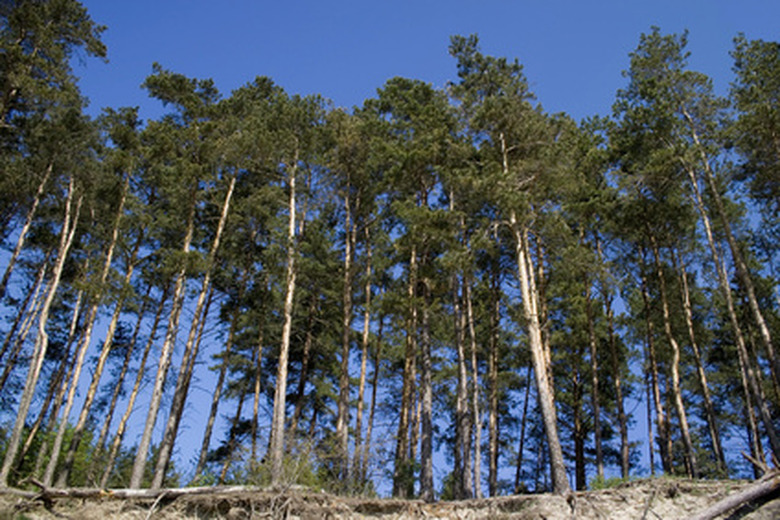Environmental Facts About Pine Trees
Pine trees can be found throughout the world in various landscapes. These trees are often found in northern regions where harsh weather occurs. Pine trees are evergreen, meaning they retain their color all year. Many types of pines are identified by their size, shape, needles and color. Each species developed to survive its environment.
Diversity
Pine trees are one of the most diverse tree species with about 110 on record. Examples include the ancient Bristlecone pine, which can be thousands of years old, according to the National Park Service. The eastern white pine is among the tallest at more than 100 feet; the mugo dwarf pine is on the opposite end of the spectrum at only 5 feet high. Other pines include lodgepole, mountain, whitebark, gray and bishop pine.
- Pine trees can be found throughout the world in various landscapes.
- Pine trees are one of the most diverse tree species with about 110 on record.
Resilience
Pine trees can grow in soil normally unsuitable for other trees. Because of their ability to withstand harsh weather, pines can grow in colder climates and very high altitudes where wind gusts often fell other trees. Pine trees can tolerate sandy and nutrient-depleted soil but cannot thrive in marshy areas. Air pollution and the pine borer are the biggest threats to pines. Both can severely damage or kill a tree.
Benefits
Pine trees pose many environmental benefits to the surrounding habitat where they are found. Several bird species eat the seeds in pine cones. The branches of these trees are used for nesting, especially where heavy snows occur. Pine needles on the ground provide sanctuary to birds during bad weather and from predators. The needles also aid in preventing soil erosion by interlocking when they fall. Nutrients used by pines are returned to the earth via the pine needles as they decompose.
- Pine trees can grow in soil normally unsuitable for other trees.
- The branches of these trees are used for nesting, especially where heavy snows occur.
Pine Needles
Because pine needles are acidic, the area around the pine tree tends to be barren of other plant life. Pine needles also are a conservation tool for water; this feature is the result of the makeup of the needles. They have less surface area, a thicker hull and more wax so water is less likely to evaporate, explains April Holladay of Wonderquest.com. This helps pine trees survive in colder climates and harsh weather.
Impact
Pines have both a beneficial and detrimental impact on the environment. Because of the acidity level in the needles, the soil near a stand of pines is highly acidic, which prevents other plant life from growing. Pines growing along waterways help prevent the erosion of stream beds or river banks. They also create a natural windbreak when grouped close together.
- Because pine needles are acidic, the area around the pine tree tends to be barren of other plant life.
